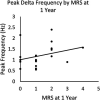Quantitative EEG as a Prognostic Tool in Suspected Anti-N-Methyl- d -Aspartate Receptor Antibody Encephalitis
- PMID: 34238869
- PMCID: PMC9886530
- DOI: 10.1097/WNP.0000000000000877
Quantitative EEG as a Prognostic Tool in Suspected Anti-N-Methyl- d -Aspartate Receptor Antibody Encephalitis
Abstract
Purpose: Anti-N-methyl- d -aspartate receptor (anti-NMDAR) encephalitis is a form of autoimmune encephalitis associated with EEG abnormalities. In view of the potentially severe outcomes, there is a need to develop prognostic tools to inform clinical management. The authors explored whether quantitative EEG was able to predict outcomes in patients with suspected anti-NMDAR encephalitis.
Methods: A retrospective, observational study was conducted of patients admitted to a tertiary clinical neuroscience center with suspected anti-NMDAR encephalitis. Peak power and peak frequency within delta (<4 Hz), theta (4-8 Hz), alpha (8 - 13 Hz), and beta (13-30 Hz) frequency bands were calculated for the first clinical EEG recording. Outcome was based on the modified Rankin Scale (mRS) score at 1 year after hospital discharge. Binomial logistic regression using backward elimination was performed with peak frequency and power, anti-NMDAR Encephalitis One-Year Functional Status score, age, and interval from symptom onset to EEG entered as predictors.
Results: Twenty patients were included (mean age 48.6 years, 70% female), of which 7 (35%) had a poor clinical outcome (mRS 2-6) at 1 year. There was no association between reported EEG abnormalities and outcome. The final logistic regression model was significant (χ 2 (1) = 6.35, P < 0.012) with peak frequency in the delta range (<4 Hz) the only retained predictor. The model explained 38% of the variance (Nagelkerke R2 ) and correctly classified 85% of cases. Higher peak frequency in the delta range was significantly associated ( P = 0.04) with an increased likelihood of poor outcome.
Conclusions: In this exploratory study, it was found that quantitative EEG on routinely collected EEG recordings in patients with suspected anti-NMDAR encephalitis was feasible. A higher peak frequency within the delta range was associated with poorer clinical outcome and may indicate anti-NMDAR-mediated synaptic dysfunction. Quantitative EEG may have clinical utility in predicting outcomes in patients with suspected NMDAR antibody encephalitis, thereby serving as a useful adjunct to qualitative EEG assessment; however, given the small sample size, replication in a larger scale is indicated.
Copyright © 2021 The Author(s). Published by Wolters Kluwer Health, Inc. on behalf of the American Clinical Neurophysiology Society.
Conflict of interest statement
The authors have no funding or conflicts of interest to disclose.
Figures


References
-
- Gibson LL, Pollak TA, Blackman G, Thornton M, Moran N, David AS. The psychiatric phenotype of anti-NMDA receptor encephalitis. J Neuropsychiatry Clin Neurosci 2019;31:70–79. - PubMed
Publication types
MeSH terms
Substances
LinkOut - more resources
Full Text Sources

